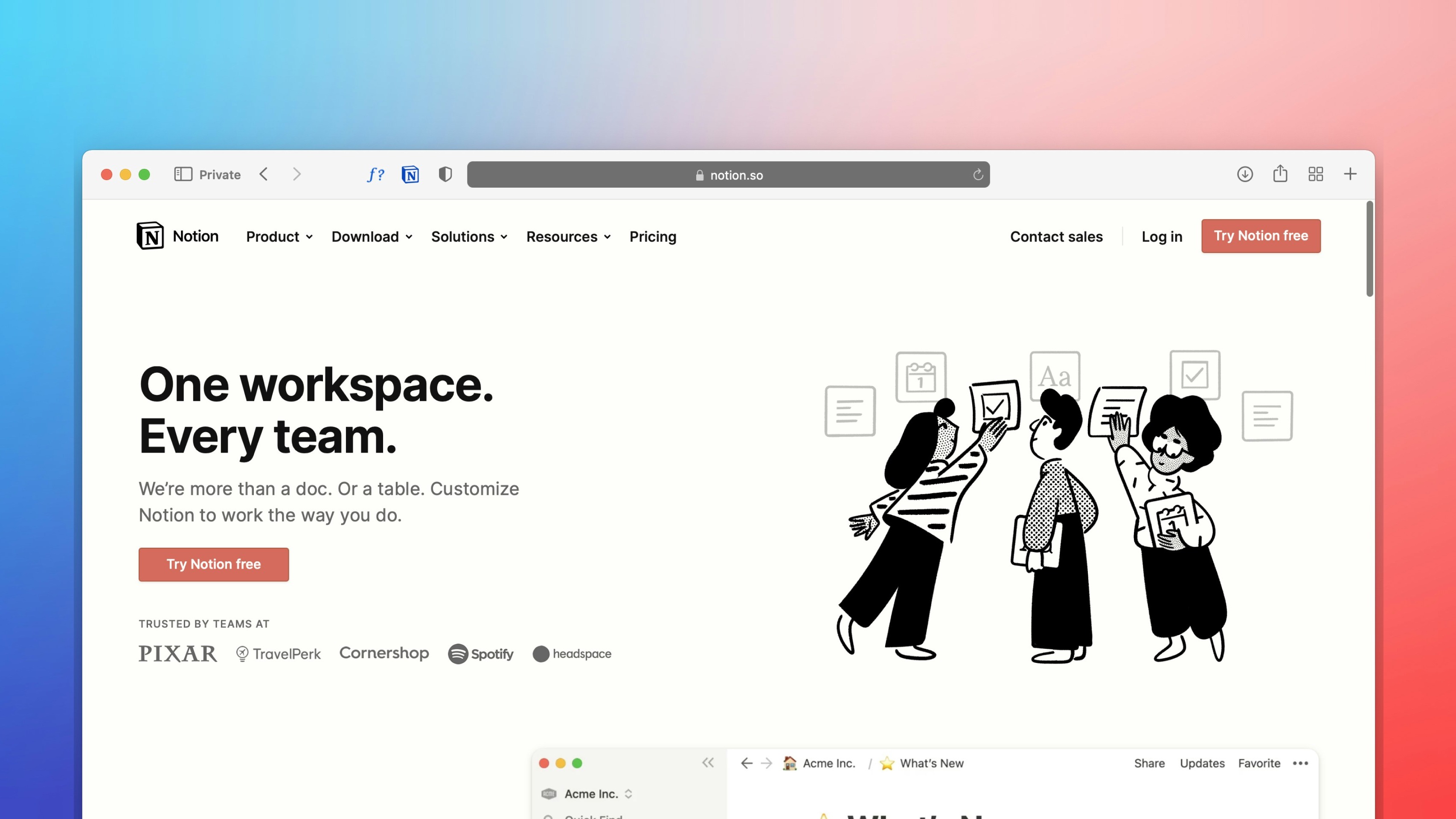 Freelancer tips
Freelancer tips Notion: What It Is, What It’s For, and How to Use It in Your Daily Life
Want to better organize your life and work? Notion can help boost your productivity. Click here to discover what this software is and what it’s used for.



For many people, working from home was once considered a utopia. Working from home, without having to go to an office, without wasting time on public transport or in a car. What we never imagined was that this wish would come true at a high cost. The joint effort of the whole world to contain the coronavirus pandemic meant we all had to stay at home and start working from living rooms, bedrooms, patios, because, let's be honest, few had a space prepared for working.
This obviously brought many difficulties, as few were aware of how to work from home, and many found it hard to adopt a routine where their whole life was now contained within the walls of their home. Having to deal with calls and demands from the boss while also watching over the kids at home is a complex situation for which very few people were prepared.
Then the pandemic ended, and many companies saw the advantages of maintaining this format. After all, they saved on space, rental costs were reduced by not needing large offices, and many expenses such as transportation or the company cafeteria, which some companies provided, were no longer as necessary.
However, for other companies, it was not at all profitable. They felt that employees were being less productive and gradually required workers to return to the offices to work regularly as they had always done. But... why does home office fail in these cases?
If you are one of those who currently must continue working from home and have not managed to get into the rhythm, don't know how to balance life and work, or simply want to improve your performance as a worker, you've come to the right place. In this article, we will be looking at everything about the home office, so without further ado, let's start.
Let's start by understanding what Home Office is. When we talk about the home office, we are referring to performing the tasks inherent to our employment outside the company's facilities. We no longer attend an office with a specific schedule; instead, we work in our home or another place of our choice where we feel comfortable. This brings many advantages to employees, starting with the fact that companies greatly flexibilize the schedules of the employees and the places from where they fulfill their obligations.
Working from Home, when applied correctly, has allowed work to be done with high levels of efficiency. What once seemed impossible is no longer so due to technological advances. Now it is possible to be in different places, in different cities, and even in different countries and see each other face to face with modern tools like Zoom.
Does this mean that face-to-face work is not necessary? Not necessarily. Companies that have focused on remote work have very specific guidelines on how to use face-to-face meetings to their advantage, reserving them for meetings or important matters that require seeing each other face to face.
It is important that we understand that these two terms, despite seeming the same, are not. On the one hand, the home office is all the work that is intended to be executed at home. Remote work, on the other hand, can be done in different places, usually where there is an Internet connection, so it is not at all strange to find people working in places like a Starbucks.
Where is the difference? In the fact that usually, you won't see a person 8 hours a day in Starbucks working, they take advantage of the environment to do some work they may need or visit these places at certain times of the week to perform some of their activities outside the usual space where they usually work. The home office, on the other hand, involves a time implication much more similar to that of an office with the only difference that you are not at home. You fulfill a working day effectively turning your home into an office.
The pandemic left the line quite blurred, but the truth is that they are different terms and we should understand the difference clearly since each one has different implications and responsibilities.
The home office had been evolving over the years, becoming an omnipresent niche in the present. Technological advances have propelled the home office, breaking the barriers that previously made it impossible. The reason for all these advances is that considerable investments have been made to develop the remote office in addition to the associated requirements due to the multiple advantages it offers. Let's analyze the advantages of the home office to try to understand why it is so popular today.
Most people have built their home as a sanctuary where they feel comfortable and have molded according to their personal tastes. This pleasant atmosphere allows people to feel much more comfortable and focus on what they are going to do without distractions or interruptions. Various reputable sources indicate that remote workers tend to be more efficient than their office counterparts, taking fewer breaks and making much better use of their hours.
When it comes to balancing personal life and work, the home office offers many things that make it superior to its face-to-face counterpart. This is due to the flexibility it offers to structure the workday around personal commitments and other family responsibilities that the worker may have. It is possible to attend any event or situation without the need to go through tedious permission processes with a boss or human resources.
People who do home office have been shown to manage their time more efficiently, integrating their workday with other types of life tasks such as household chores or childcare. Considering that the travel time to the office is eliminated, time is used more effectively reducing stress levels in people.
Not only is there a saving of time, but also of money. By eliminating trips to the office, people are also reducing the expenses associated with this. Fuel costs, tolls, public transport tickets, among others, are reduced. Similarly, formal suits and dresses become less necessary and laundry expenses are reduced. As mentioned before, companies can also see a reduction in expenses by not having to pay rents for huge offices, in addition to saving considerably on utility bills.
There are also many people who cannot prepare lunches and breakfasts because they must make the journey to work. Working from home allows them to take advantage of the time to make more nutritious meals and improve their diet. The time saved can be used to invest in personal development, such as reading a book or going to the gym.
Employees who work in Home Office tend to be more committed and this satisfaction results in an increase in their retention. This feeling of flexibility and autonomy often reflects a strong feeling of appreciation from employees towards the company. As a result, they start to be more productive and efficient, staying longer in the company, reducing the recruitment and training costs of new employees.
By not being limited to the city where it is located, the Home Office allows companies to dive into a much larger pool of talent than if they were only limited to local talent. Companies can recruit top-level talent, and retain it by offering the flexibility we have discussed earlier.
An indirect advantage of this is that it fosters the integration and diversity of different cultures within the company's workforce. Remote work favors collaboration between different time zones, allowing companies to operate on a global scale and interact with customers, employees, and partners on a global scale.
If there was something we learned from the pandemic, it is that not all companies were prepared to face such a level of disruption. Will companies be prepared for the next global-scale disaster?
The possibility of working remotely is really useful when it comes to times of crisis or disruption like the ones we lived through a couple of years ago. Companies with remote work policies and schemes can adapt better to any sudden catastrophe situation and can maintain their productivity and service without facing any difficulty.
As we have seen, the Home Office has brought multiple advantages in recent years, both for workers and for companies, offering a large number of benefits, from flexibility to a demonstrated increase in productivity that is based on a better balance between work and personal life.
But as the saying goes, not all that glitters is gold, and the Home Office also has a series of challenges that must be overcome to have successful performance from home. Let's analyze some of these challenges and see how we can overcome them in a practical way.
The common denominator tends to be that not all people have a suitable place to work at home. This was frequently seen in the pandemic when many workers had to improvise corners in their homes that could serve as workplaces. They immediately found themselves in uncomfortable places with less than adequate furniture to spend several hours a day working.
The first thing you should do is look for a place in your house where you feel concentrated and that you can focus on doing your job. After that, it's time to adapt it to meet all your comforts. Although this was somewhat complicated during the pandemic, now we have more freedom to furnish, adjust, and decorate our work corner in the way we consider most convenient.
Make sure you have good lighting, comfortable furniture, and don't forget a comfortable chair, this is essential for the proper development of your daily work activities. Remember, this will be your space.
This is one of the main arguments used by opponents of remote work to reduce its impact in modern times, and they do so with some degree of reason. Being at home generates a lot of distractions. Our family members or roommates, household chores, and often even our own room calling us to rest a bit more are potentially lethal distractions for productivity and concentration.
To counter this, it's necessary to develop certain limits first with yourself. Remember, the success of working from home is based on maintaining a notable level of discipline. The same goes for personal interactions, whether live or digital. Constant notifications on the phone are one of the main productivity killers.
Try the Pomodoro technique, which allows you to work in small blocks with short breaks, periodically allowing you to distract yourself or check your phone. This is a proven method for achieving goals and completing tasks on time.
If people in your environment tend to interrupt, you're not alone. Hundreds of thousands of workers around the world suffer the same thing. The best thing you can do is establish a schedule where you ask not to be disturbed. Similarly, you can agree on a signal that when others see it they immediately think, “They're working,” something like the Do Not Disturb sign we find in hotels.
If you have children, this may be a bit more difficult. Your partner can be your best support. If both of you are dedicated to remote work, you can coordinate your schedules so that you can have different time blocks to take care of the children.
One of the big problems with the home office is that the lack of routine causes a disruption in healthy patterns, mostly associated with those who work outside the home. Many people adopt less healthy patterns when they have more time, such as sleeping too much or stopping cooking to order junk food at home.
It's important for your well-being to resist this temptation. To stay productive, you need to be rested, well-fed, and in shape. Just like your car that needs good quality fuels and lubricants, you also have certain requirements to keep operating at a high level.
The best way to combat this challenge is to have a routine, use weekends to prepare meals that you can consume during the week. That way while you work you can think about that delicious dish waiting for you at mealtime. It's really worth it.
Depending on your personality, working in isolation brings different challenges. Despite our nature, we are all social beings. There are people who enjoy the office environment because they can spend time with many people and interact with all of them. On the other hand, there are people who prefer to be only with one or two people they fully trust.
But the truth is that for either case, working from home means we depend on cold emails for our interactions with colleagues and friends. In these cases, remember that you have videoconferencing tools that can help you break the distance barrier a bit. And if you feel you need closer contact occasionally, you can try meeting with your coworkers to share a meal or some drinks from time to time.
This is one of the biggest problems faced by all people who work from home, losing track of time to the point of working excessive amounts, after all, this office doesn’t close! You must be careful not to fall into this trap.
Similarly, procrastination is deadly when it comes to home office environments. Don't rest too much, but also don't overwork. The key is balance. We know it can be complicated, but it's key to achieving positive results in the home office.
A successful home office routine requires commitment and meticulous planning. You should look for strategies that enhance productivity and minimize distractions, maintaining a positive balance between personal life and work.
The first thing that should be clear to everyone in the company is their roles, goals, and objectives. Employees should know their leaders, who should be in contact with them and use tools to track and advance operations.
Although remote work allows us some freedom in setting our schedule, having too much freedom can be a problem. The same happens when you have a space to work at home. That place becomes your sanctuary and sitting there will activate 'beast mode' to accomplish everything you need to do in the day.
Remember that discipline is necessary in the midst of what you do. Flexibility is a double-edged sword. If we want the company to honor commitments of flexible hours and flexibility with us, it is imperative that we can also honor our commitment to productivity and goal achievement. This is the best way to shut up all the detractors of the home office.
Effectively managing a workforce that works remotely may require different tools to increase monitoring, productivity, and team focus.
Project management tools are essential within this. These tools help you plan, organize, and track tasks, ensuring that projects are completed on time and within budget, and they can also be useful for detecting when something is not being met to make corrections before it's too late. The most popular options are Asana, Trello, and Basecamp.
Next are time control tasks. These tools help you track the time you spend on specific tasks, allowing you to better manage your workload and identify areas for improvement. Among the recommended options are Toggl, Harvest, and RescueTime.
Being remote, communication becomes crucial and important. You need reliable communication tools that allow you to stay connected with the team. Slack, Microsoft Teams, and Zoom are popular options for instant messaging, video conferencing, and file sharing.
Information exchange is essential and is something that emails can do with less and less efficiency. Using cloud storage services is essential to be able to exchange information. Services like Dropbox, Google Drive, or OneDrive. Programmers increasingly use tools like GitHub to keep track of projects and versions.
Improve your concentration and productivity with apps like Evernote for note-taking, Notion for organizing information, and Forest for maintaining focus. These can be adopted within each person's workflow. You can minimize distractions and stay on course with tools like Freedom, SelfControl, and Cold Turkey.
Security is very important when working remotely. Being outside the company's secure environment, it became much easier for malicious attackers to try to take control of essential assets for the company. Password managers like LastPass, 1Password, and Bitwarden help keep passwords secure and add an additional layer of security.
There are countless tools within the home office ecosystem, you should look for those that suit you and your needs to meet the company's goals.
To conclude, we want to leave you some tips so that your workspace is optimal and comfortable for your remote work sessions. The workspace is a key factor for productivity and well-being during the home office. A well-designed and organized space can help improve concentration, motivation, and health.
Avoid working in spaces with a lot of noise or distractions. Natural lighting is ideal, but if not possible, use proper artificial lighting. Make sure you have enough space to work comfortably and organize your materials. If possible, include a desk, an ergonomic chair, a computer, and other necessary equipment.
Create an environment that inspires you, you can do this by adding personal and decorative elements that make you feel comfortable and motivated, and obviously, you must maintain order, there is nothing more counterproductive for productivity than cluttered spaces.
Finally, we recommend using remote job search platforms. On these sites there are a lot of job opportunities designed for you, so they will help you locate the jobs that best suit your interests and skills.
In addition, you always have the possibility to try working for a foreign company online without the need to leave home. The best thing is that the balance between your life and your job will remain the same.
And if you are worried about payment, consider using DolarApp as a method to receive money. It doesn't matter if it's in dollars, the service allows you to change to pesos at the best exchange rate.
Remote work and the home office can be fun and enjoyable, but they have a high potential to become chaotic. By applying all the tips we've talked about in this article, you can achieve a perfect balance between work effectiveness and a free and fulfilling life to enjoy.

The world has borders. Your finances don’t have to.
 Freelancer tips
Freelancer tips Want to better organize your life and work? Notion can help boost your productivity. Click here to discover what this software is and what it’s used for.

 Freelancer tips
Freelancer tips Project chaos? Learn how Trello can help you organize tasks and improve your productivity.

 Freelancer tips
Freelancer tips ClickUp can make any freelancer more productive. Discover what it is, how it works, and the advantages this tool offers you


